1996 CHEVROLET BLAZER power steering
[x] Cancel search: power steeringPage 74 of 392
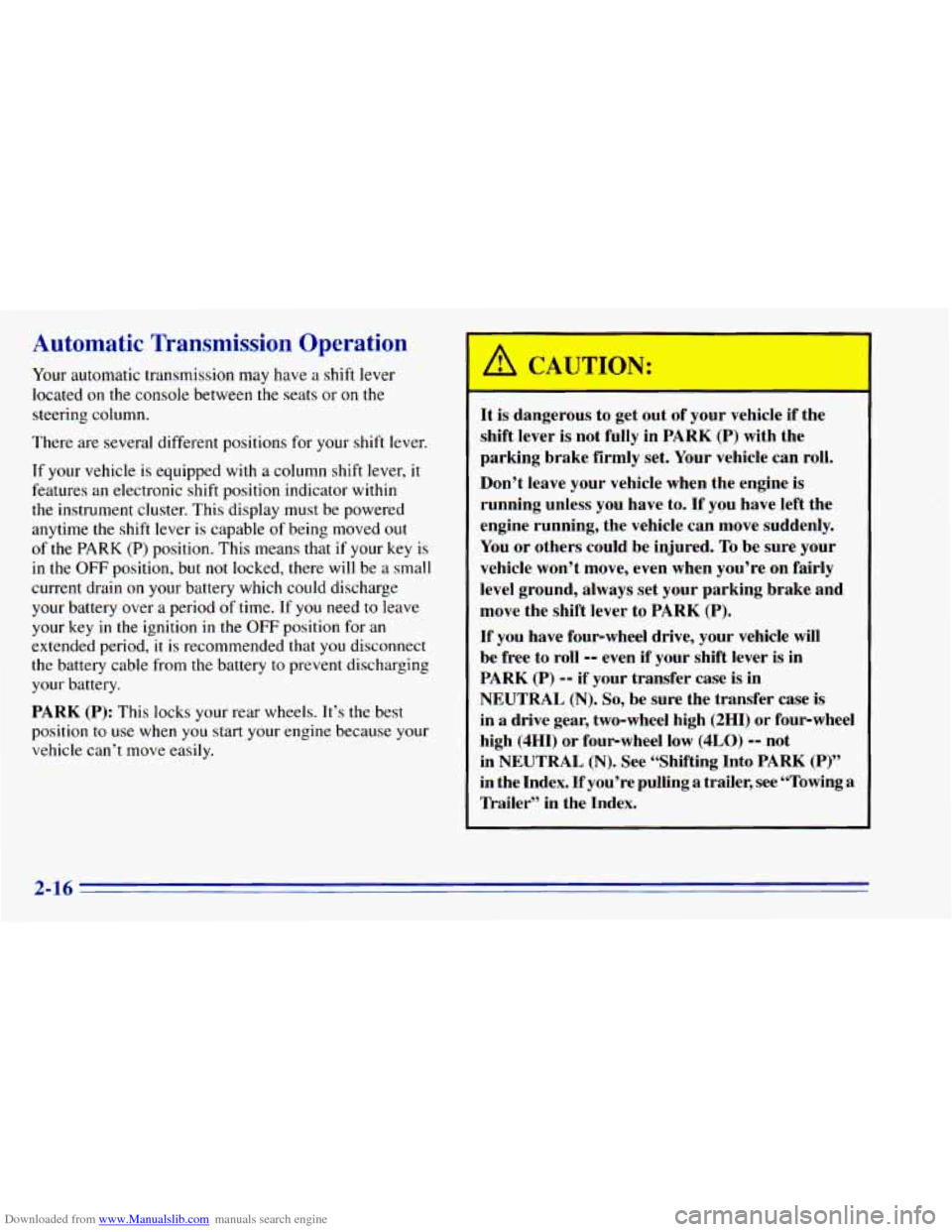
Downloaded from www.Manualslib.com manuals search engine Automatic Transmission Operation
Your automatic transmission may have a shift lever
located
on the console between the seats or on the
steering column.
There are several different positions for your shift lever.
If your vehicle is equipped with a column shift lever,
it
features an electronic shift position indicator within
the instrument cluster. This display must be powered
anytime
the shift lever is capable of being moved out
of the PARK (P) position. This means that if your key is
in the
OFF position, but not locked, there will be a small
current drain
on your battery which could discharge
your battery over
a period of time. If you need to leave
your key
in the ignition in the OFF position for an
extended period, it is recommended that you disconnect
the battery cable from the battery
to prevent discharging
your battery.
PARK (P): This locks your rear wheels. It’s the best
position
to use when you start your engine because your
vehicle can’t move easily.
D
It is dangerous to get out of your vehicle if the
shift lever is not fully in
PARK (P) with the
parking brake firmly
set. Your vehicle can roll.
Don’t leave your vehicle when the engine is
running unless you have to. If you have left the
engine running, the vehicle can move suddenly.
You or others could be injured.
To be sure your
vehicle won’t move, even when you’re on fairly
level ground, always set your parking brake and
move the shift lever to
PARK (P).
If you have four-wheel drive, your vehicle will
be free to roll
-- even if your shift lever is in
PARK (P) -- if your transfer case is in
NEUTRAL (N). So, be sure the transfer case is
in
a drive gear, two-wheel high (2HI) or four-wheel
high (4HI) or four-wheel low
(4LO) -- not
in
NEUTRAL (N). See “Shifting Into PARK (P)”
in the Index. If you’re pulling a trailer, see “Towing a
’Ikailer” in the Index.
2-16
Page 162 of 392
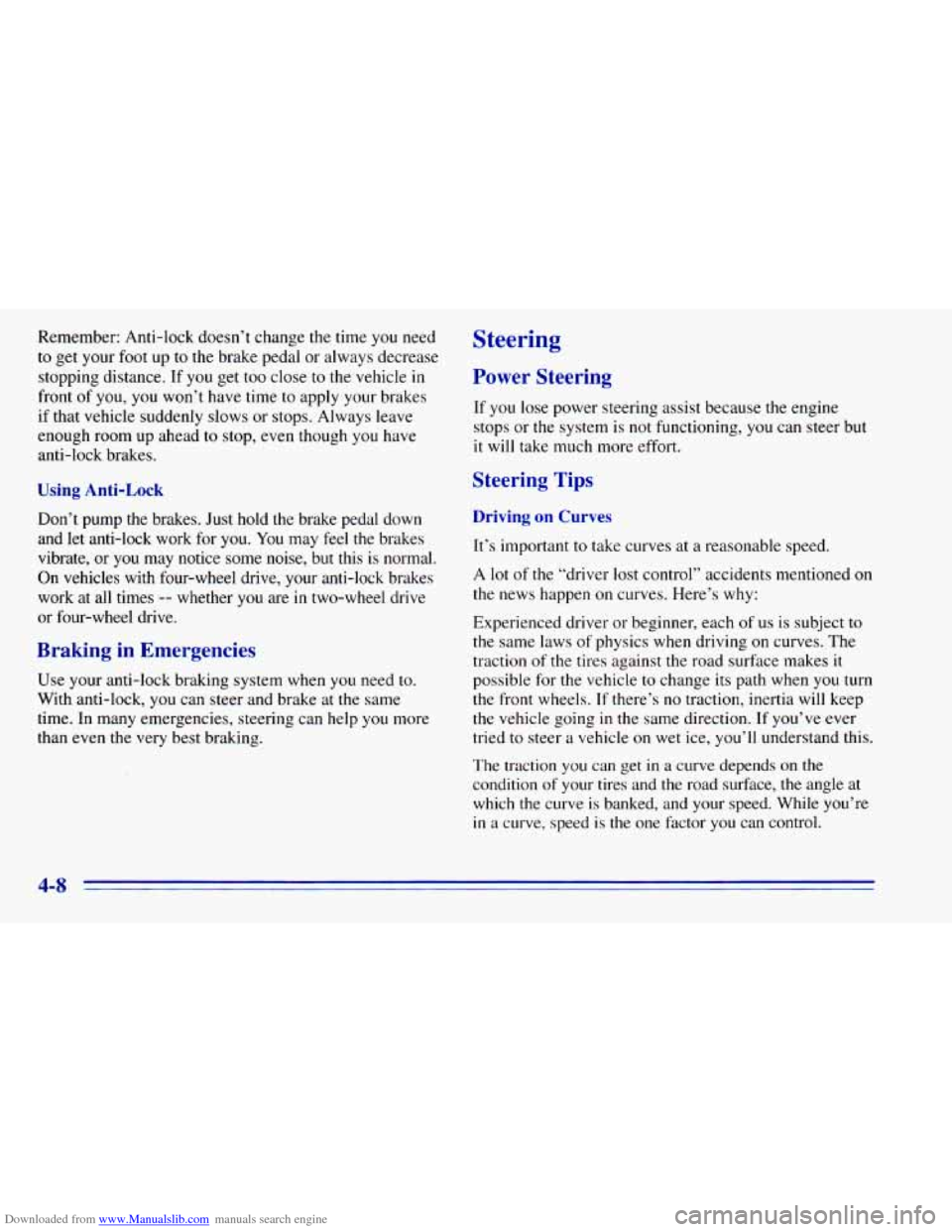
Downloaded from www.Manualslib.com manuals search engine Remember: Anti-lock doesn’t change the time you need
to get your foot up
to the brake pedal or always decrease
stopping distance. If
you get too close to the vehicle in
front of you, you won’t have time to apply your brakes
if that vehicle suddenly slows or stops. Always leave
enough room up ahead to stop, even though
you have
anti-lock brakes.
Using Anti-Lock
Don’t pump the brakes. Just hold the brake pedal down
and let anti-lock work for you. You may feel the brakes
vibrate, or
you may notice some noise, but this is normal.
On vehicles with four-wheel drive, your anti-lock brakes
work at all times
-- whether you are in two-wheel drive
or four-wheel
drive.
Braking in Emergencies
Use your anti-lock braking system when you need to.
With anti-lock, you can steer and brake at the same
time. In many emergencies, steering can help you more
than even the very best braking.
Steering
Power Steering
If you lose power steering assist because the engine
stops or the system is not functioning, you can steer but
it will take much more effort.
Steering Tips
Driving on Curves
It’s important to take curves at a reasonable speed.
A lot of the “driver lost control” accidents mentioned on
the news happen
on curves. Here’s why:
Experienced driver or beginner, each
of us is subject to
the same laws
of physics when driving on curves. The
traction
of the tires against the road surface makes it
possible
for the vehicle to change its path when you turn
the front wheels.
If there’s no traction, inertia will keep
the vehicle going
in the same direction. If you’ve ever
tried to steer a vehicle on wet ice, yodll understand this.
The traction you can get in a curve depends on the
condition
of your tires and the road surface, the angle at
which the curve
is banked, and your speed. While you’re
in
a curve, speed is the one factor you can control.
4-8
Page 174 of 392
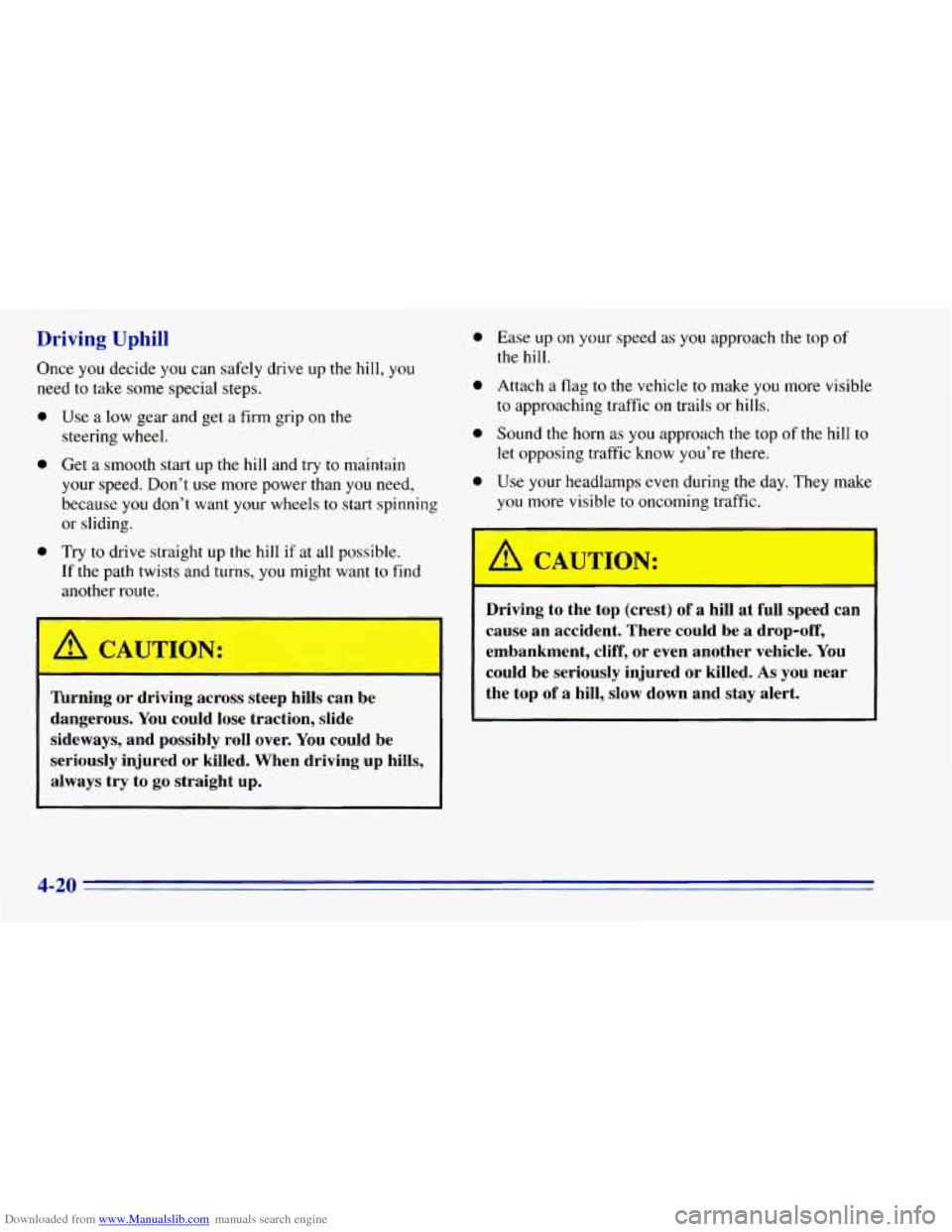
Downloaded from www.Manualslib.com manuals search engine Driving Uphill
Once you decide you can safely drive up the hill, you
need to take some special steps.
0 Use a low gear and get a firm grip on the
0 Get a smooth start up the hill and try to maintain
steering wheel.
your speed. Don’t
use more
power than you need,
because
you don’t want your wheels to start spinning
or sliding.
If the path twists and turns, you might want to find
another route.
0 Try to drive straight up the hill if at all possible.
0
0
0
0
Ease up on your speed as you approach the top of
the hill.
Attach a flag
to the vehicle to make you more visible
to approaching traffic
on trails or hills.
Sound
the horn as you approach the top of the hill to
let opposing traffic know you’re there.
Use your headlamps even during the day. They make
you more visible
to oncoming traffic.
Awning or driving across steep hills can be
dangerous.
You could lose traction, slide
sideways, and possibly roll over.
You could be
seriously injured or killed. When driving up hills,
always try to
go straight up.
A CAUTION: I
Driving to the top (crest) of a hill .at full speed can
cause an accident. There could be
a drop-off,
embankment, cliff, or even another vehicle.
You
could be seriously injured or killed. As you near
the top
of a hill, slow down and stay alert.
4-20
Page 256 of 392
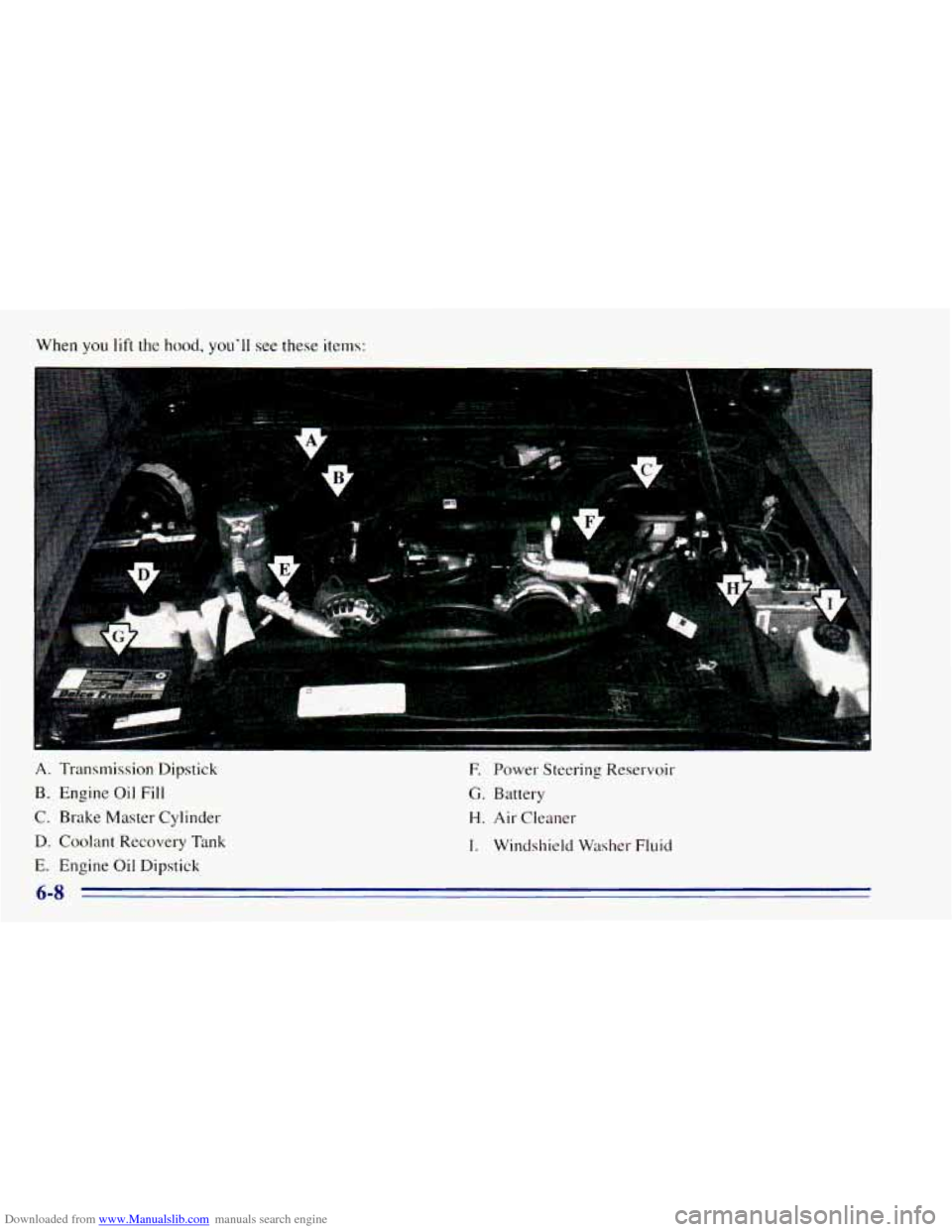
Downloaded from www.Manualslib.com manuals search engine When you lift the hood, you'll see these items:
A. Transmission Dipstick
B. Engine Oil Fill
C. Brake Master Cylinder
D. Coolant Recovery Tank
E. Engine Oil Dipstick F.
Power Steering Reservoir
G. Battery
H. Air Cleaner
I. Windshield Washer Fluid
6-8
Page 274 of 392
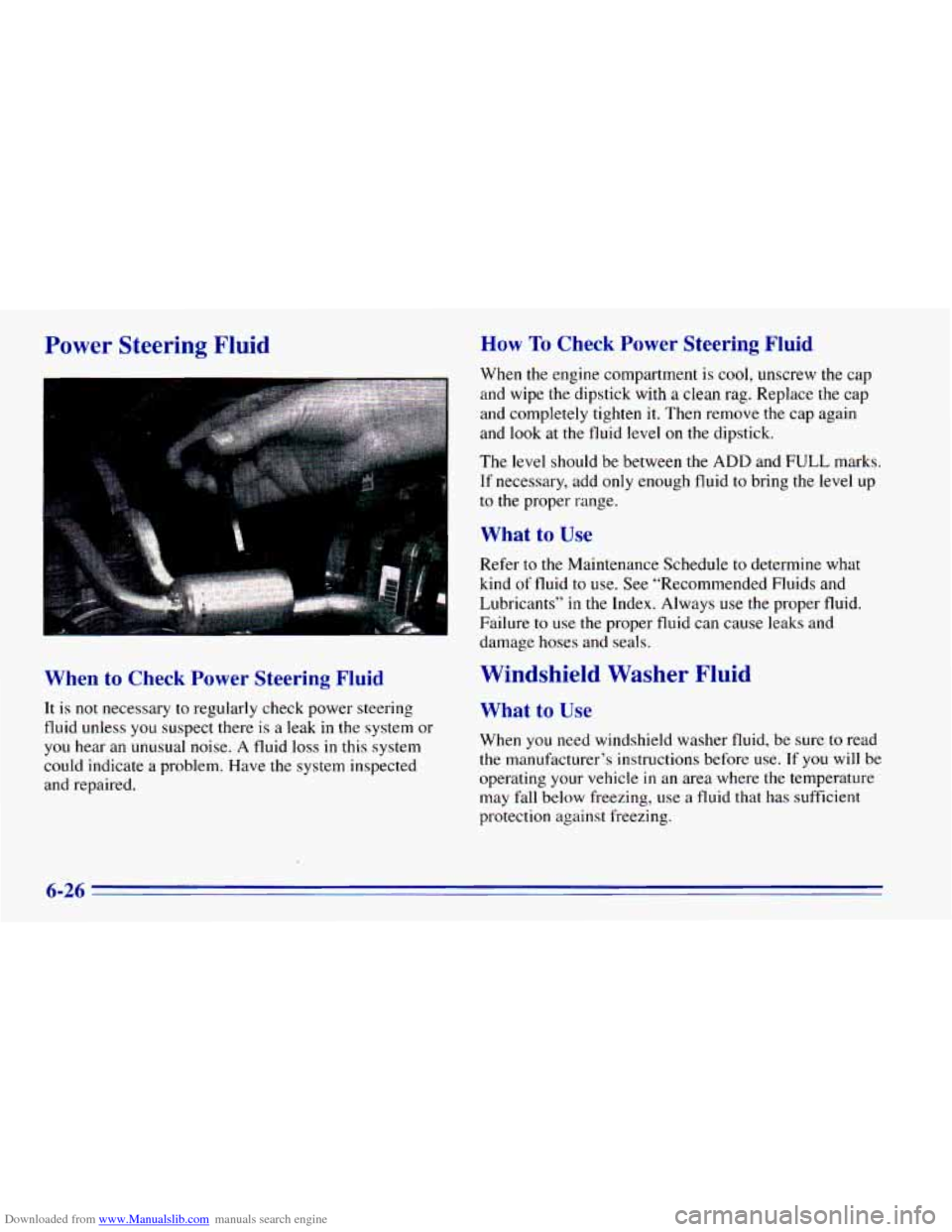
Downloaded from www.Manualslib.com manuals search engine Power Steering Fluid
When to Check Power Steering Fluid
It is not necessary to regularly check power steering
fluid unless you suspect there
is a leak in the system or
you hear an unusual noise.
A fluid loss in this system
could indicate a problem. Have the system inspected
and repaired.
How To Check Power Steering Fluid
When the engine compartment is cool, unscrew the cap
and wipe the dipstick
with a clean rag. Replace the cap
and completely tighten it. Then remove the cap again
and look at the fluid level on the dipstick.
The level should be between the
ADD and FULL marks.
If necessary, add
only enough fluid to bring the level up
to the proper range.
What to Use
Refer to the Maintenance Schedule to determine what
kind
of fluid to use. See “Recommended Fluids and
Lubricants”
in the Index. Always use the proper fluid.
Failure to use the proper fluid can cause leaks and
damage hoses and seals.
Windshield Washer Fluid
What to Use
When you need windshield washer fluid, be sure to read
the manufacturer’s instructions before use. If you will be
operating your vehicle
in an area where the temperature
may fall below freezing, use a fluid that
has sufficient
protection against freezing.
6-26
Page 363 of 392
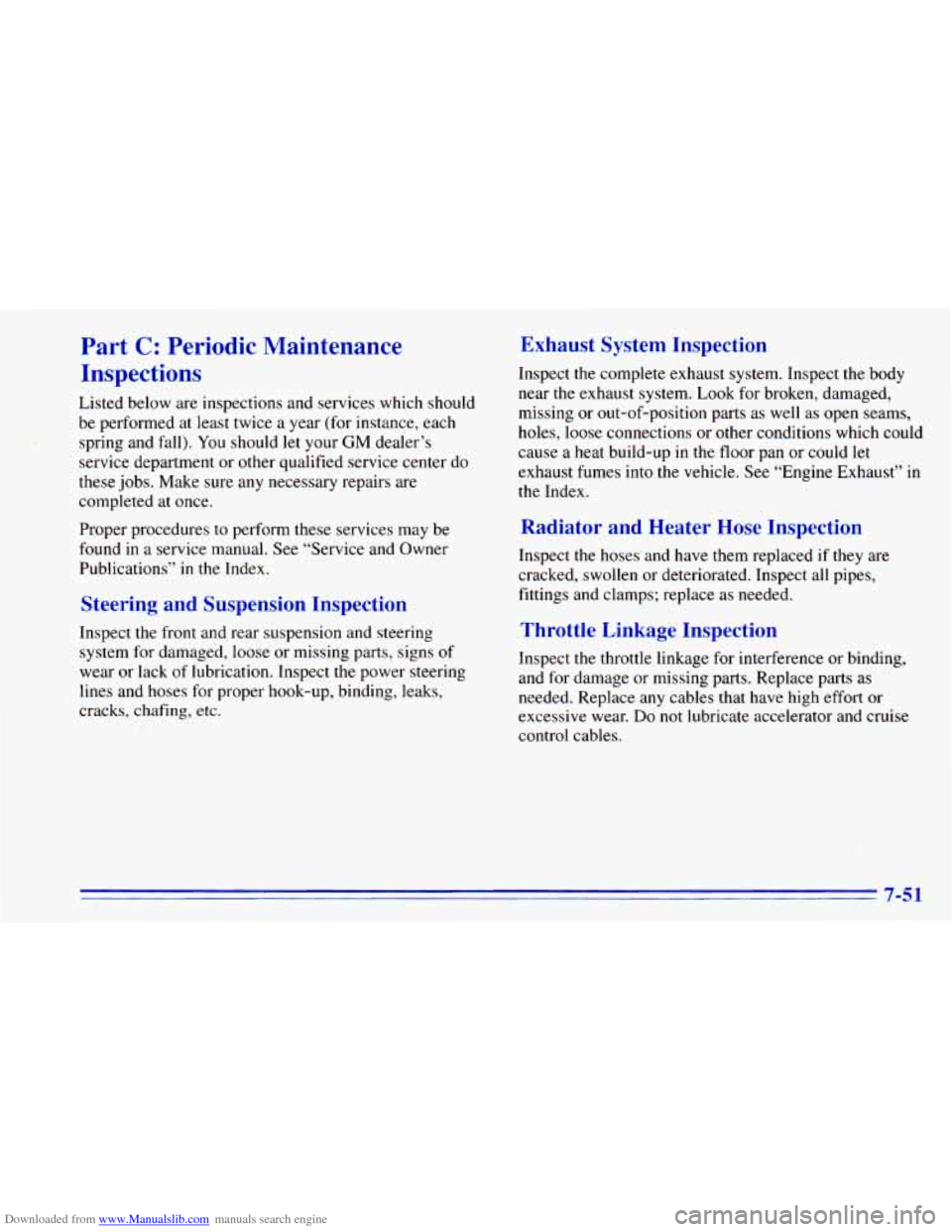
Downloaded from www.Manualslib.com manuals search engine Part C: Periodic Maintenance
Inspections
Listed below are inspections and services which should
be performed at least twice a year (for instance, each
spring and fall). You should let your
GM dealer’s
service department or other qualified service center do
these jobs. Make sure any necessary repairs are
completed at once.
Proper procedures to perform these services may be
found
in a service manual. See “Service and Owner
Publications”
in the Index.
Steering and Suspension Inspection
Inspect the front and rear suspension and steering
system for damaged, loose or missing parts, signs of
wear or lack of lubrication. Inspect the power steering
lines and hoses for proper hook-up, binding, leaks,
cracks, chafing, etc.
Exhaust System Inspection
Inspect the complete exhaust system. Inspect the body
near
the exhaust system. Look for broken, damaged,
missing or out-of-position parts as well as open seams,
holes, loose connections or other conditions which could
cause a heat build-up
in the floor pan or could let
exhaust fumes into the vehicle. See “Engine Exhaust” in
the Index.
Radiator and Heater Hose Inspection
Inspect the hoses and have them replaced if they are
cracked, swollen or deteriorated. Inspect all pipes,
fittings and clamps; replace as needed.
Throttle Linkage Inspection
Inspect the throttle linkage for interference or binding,
and for damage or missing parts. Replace parts
as
needed. Replace any cables that have high effort or
excessive wear. Do not lubricate accelerator and cruise
control cables.
7-51
Page 365 of 392
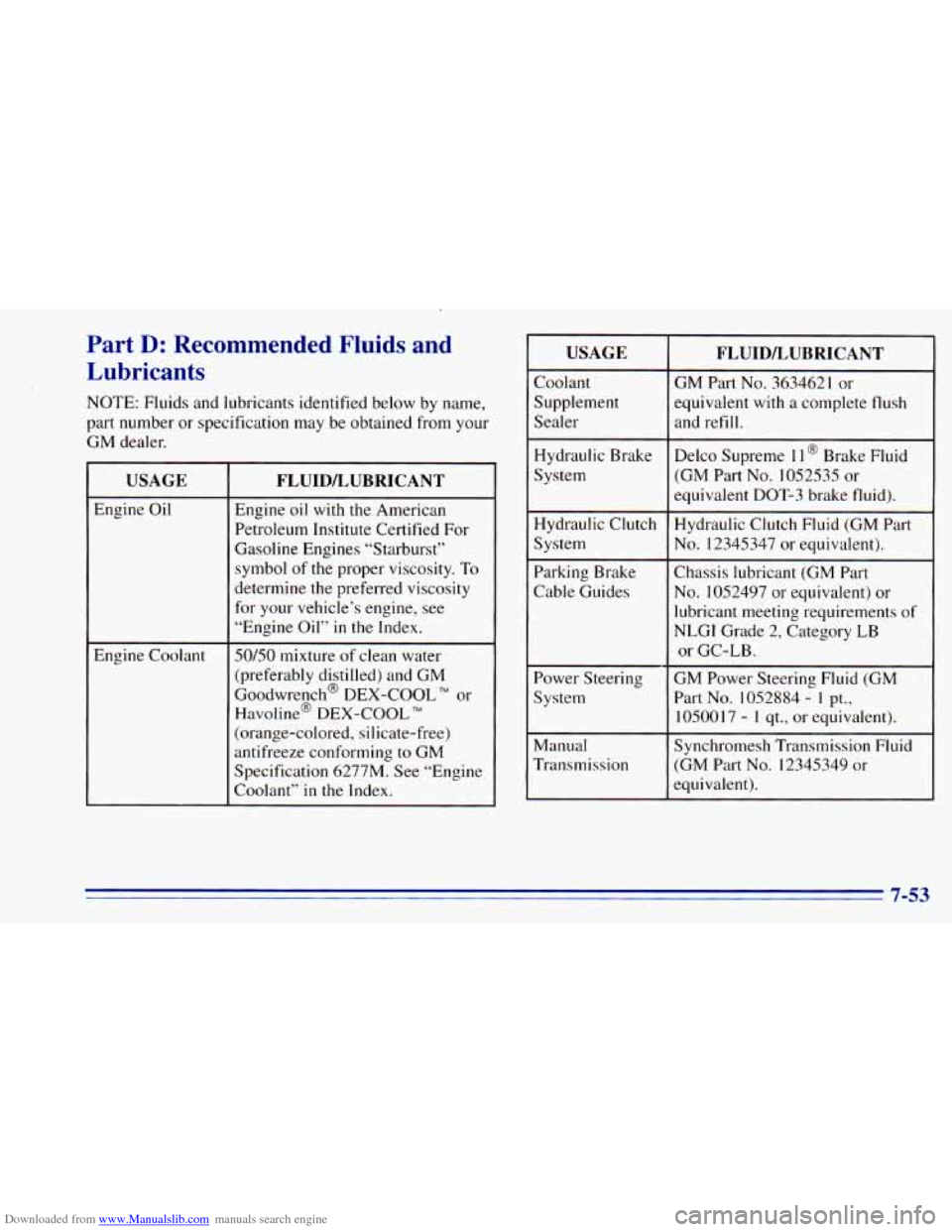
Downloaded from www.Manualslib.com manuals search engine Part D: Recommended Fluids and
Lubricants
NOTE: Fluids and lubricants identified below by name,
part number or specification may be obtained from your
GM dealer.
USAGE
Engine Oil
Engine Coolant
FLUIDLUBRICANT
Engine oil with the American
Petroleum Institute Certified For
Gasoline Engines “Starburst”
symbol
of the proper viscosity. To
determine the preferred viscosity
for your vehicle’s engine, see
“Engine Oil”
in the Index.
50/50 mixture of clean water
(preferably distilled) and GM
Goodwrench@ DEX-COOL
TM or
Havoline@
DEX-COOL TM
(orange-colored, silicate-free)
antifreeze. conforming
to GM
Specification 6277M. See “Engine
Coolant’‘
in the Index.
USAGE
Coolant
Supplement
Sealer
Hydraulic Brake
System
Hydraulic Clutch
System
Parking Brake
Cable Guides
Power Steering
System
Manual
Transmission
FLUIDLUBRICANT
GM Part No. 3634621 or
equivalent with a complete flush
and
refi 11.
Delco Supreme I 1 @ Brake Fluid
(GM Part
No. 1052535 or
equivalent DOT-3 brake fluid).
Hydraulic Clutch Fluid (GM Part
No. 12345347 or equivalent).
Chassis lubricant (GM Part
No. 1052497 or equivalent) or
lubricant meeting requirements
of
NLGI Grade 2, Category LB
or GC-LB.
GM Power Steering Fluid (GM
Part
No. 1052884 - 1 pt.,
1050017
- 1 qt., or equivalent).
Synchromesh Transmission Fluid
(GM Part
No. 12345349 or
equivalent).
7-53
Page 386 of 392
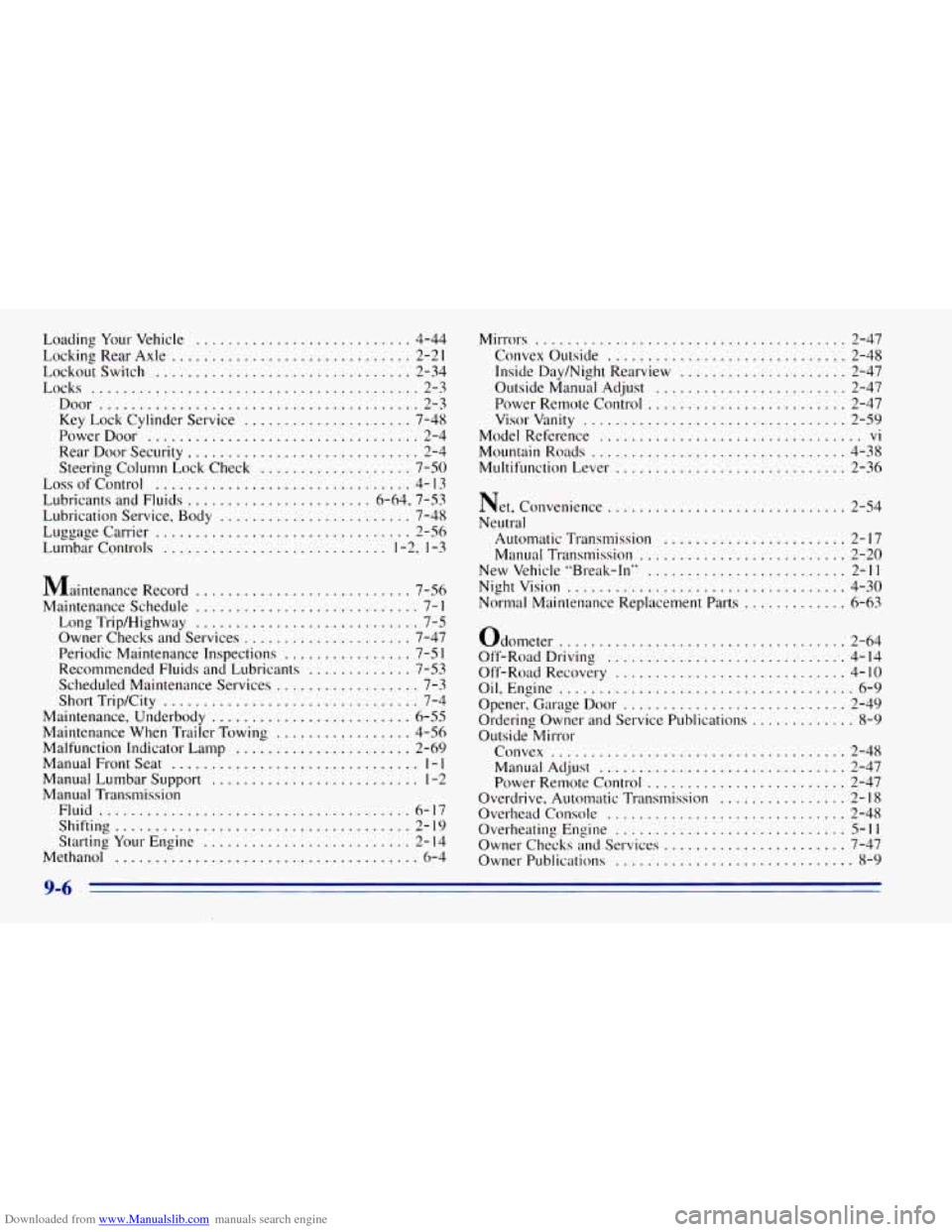
Downloaded from www.Manualslib.com manuals search engine Loading Your Vehicle ........................... 4-44
Locking Rear Axle
.............................. 2-2 1
Lockoutswitch ................................ 2-34
Locks
......................................... 2-3
Door
........................................ 2-3
Key Lock Cylinder Service
..................... 7-48
PowerDoor
.................................. 2-4
Rear Door Security
............................. 2-4
Steering Column Lock Check
................... 7-50
Loss
of Control ................................ 4- I3
Lubricants and Fluids ....................... 6.64. 7.53
Lubrication Service. Body
........................ 7-48
Luggagecarrier
................................ 2-56
Lumbar Controls
............................ 1.2 . 1-3
Maintenance Record ........................... 7-56
Maintenance Schedule
............................ 7- 1
Long Trip/Highway ............................ 7-5
Owner Checks and Services
..................... 7-47
Periodic Maintenance Inspections
................ 7-5 1
Recommended Fluids and Lubricants ............. 7-53
Scheduled Maintenance Services
.................. 7-3
Short Trip/City
................................ 7-4
Maintenance. Underbody
......................... 6-55
Maintenance When Trailer Towing ................. 4-56
Malfunction Indicator Lamp
...................... 2-69
ManualFrontSeat
............................... 1-1
Manual Lumbar Support .......................... 1-2
Manual Transmission
Fluid
..................................... 6-17
Shifting
........................... ..... 2-19
Starting Your Engine
.............. ... 2-14
Methanol
...................................... 6-4 Mirrors
....................................... 2-47
Convex Outside
.............................. 2-48
Inside Day/Night Rearview ..................... 2-47
Power Remote Control
......................... 2-47
Visorvanity
................................. 2-59
Model Reference
................................. vi
Mountain Roads ................................ 4-38
Multifunction Lever
............................. 2-36
Net. Convenience
.............................. 2-54
Neutral Automatic Transmission
....................... 2-17
Manual Transmission
.......................... 2-20
New Vehicle “Break-In”
......................... 2-11
Nightvision ................................... 4-30
Normal Maintenance Replacement Parts
............. 6-63
Outside Manual Adjust
........................ 2-47
Odometer
.................................... 2-64
Off-Road Driving
.............................. 4-14
Off-Road Recovery
............................. 4- IO
Oil. Engine ..................................... 6-9
Opener. Garage Door
............................ 2-49
Ordering Owner and Service Publications
............. 8-9
Outside Mirror Convex
..................................... 2-48
Manual
Adjust ............................... 2-47
Power Remote Control
......................... 2-47
Overdrive. Automatic Transmission
................ 2-18
Overhead Console
.............................. 2-48
Overheating Engine
............................. 5-11
Owner Checks and Services ....................... 7-47
Owner Publications
.............................. 8-9
9-6